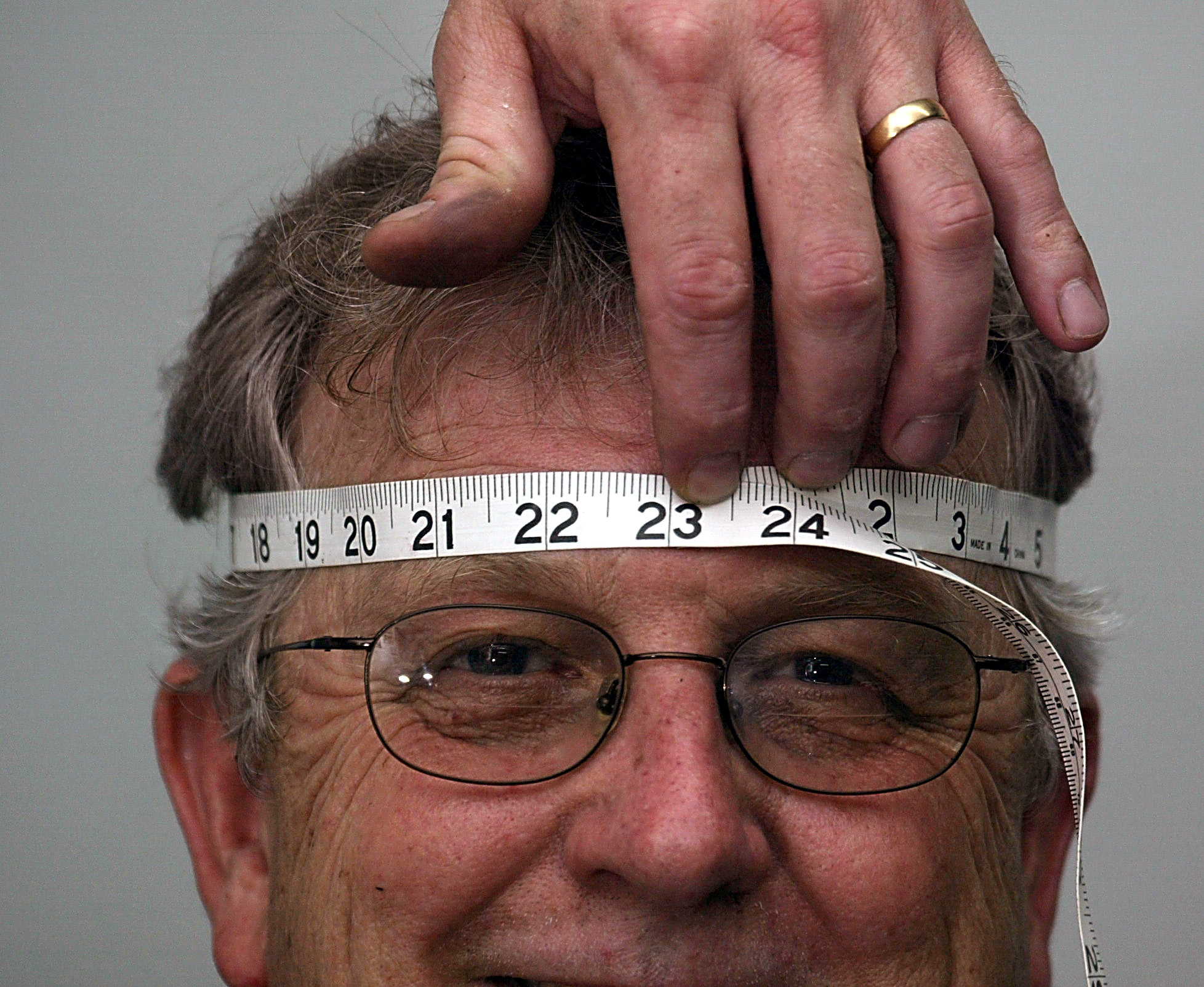“Helmet fit is critical,” says Bell’s Kyle Kietzmann. “Some people don’t spend enough time making sure that they have a properly-fitting helmet, but fit is crucial to helmet performance.
“Some people gravitate toward a helmet that is too big because they feel more comfortable when it’s a little looser, but that tight fit is critical. A helmet that’s too large can shift during impact, which reduces its overall effectiveness. Or if it’s grossly mis-sized, it can come off.”
For measurement, Simpson’s Gary Peters says, “Use a cloth tape measure, like for sewing, and place it right above your brow line. Measure the circumference of the widest part of your head. It will tell you the hat or helmet size.” Most manufacturers have a cross reference chart on their website or in their catalog.
The area measured is called the crown. “If you drew a line around your head—that is the area that needs to fit as snug as you can stand it without creating pressure points,” says Impact Racing’s John Dambros. “It is the most important area for fit because the primary purpose of a helmet is to protect the brain, so we spent a lot of time in the crown area.”
The crown size is a vital measurement, but it doesn’t tell the whole story since head shapes vary. “Studies show there are some standard head forms, but there are combinations of oval-round shapes and round-oval and round-square,” says Dambros.
The product shape varies, too. “All helmets have differently shaped insides,” says Kietzmann. “One may have a traditional European head shape, where it’s kind of longer and a little more narrow on the sides, instead of an Asian head shape, which is typically more round. Those helmets are going to fit differently.”
Since head and helmet shapes vary, finding the best fit takes more than 30 seconds and a tape measure. Manufacturers agree that if you’re getting a first helmet or switching brands, it’s best to visit a retailer and try them on. “We recommend trying on a helmet somewhere, but if that’s not reasonable, we can use the measuring system,” says Peters. The step-by-step process helps determine the best fit available.
If your local speed shop is a stocking dealer of helmets, they offer the opportunity to try on various sizes and brands. Tradeshows are an excellent place to try helmets, too. Don’t forget to bring your glasses and headsock if you wear them.
If you’re doing mail order and it isn’t right, be prepared to return it. “Shipping is cost-effective, so a buyer should be prepared to return the product because it doesn’t fit, work with his glasses, or for whatever reason,” says G-Force’s Jeremy Curtis. “If you’re buying mail order, don’t say it’s good enough if it isn’t. But don’t wear it racing, then expect to return it either.” Also noted by manufacturers, don’t have a $700 custom paint job applied before making sure the helmet fits.
“A good percentage of our business is return customers, racers who know what they want and are comfortable ordering online,” says Pyrotect’s Bob Weiss. “If somebody is unclear on how to size, fit, or order a helmet, we’ll walk them through the process.”
Choose the brand you’d like to wear and the size that matches your initial measurement, but keep in mind that actual fit is more important than particular size. “The difference may be only an eighth of an inch, but in circumference that’s a whole size difference,” says Dambros.
Pull one off the shelf and put it on. “It should fit as tight as comfortably possible,” says Curtis. “Your head and face need to be cocooned as snuggly as possible in that helmet. And they do break in over time.”
A helmet that feels a little too tight when new will relax. “Go with the smallest size that’s not going to create any discomfort,” says Kietzmann. “The interior of the helmet can condense as much as a half a hat size, so wear it for five or 10 minutes before making a decision that it’s too small.” You may feel a little ridiculous walking around the store with a helmet on, but that’s better than regretting that you didn’t.
Once you’ve found a helmet in a size that’s worth pursuing, there are several steps to ensure a good fit. “Make sure the helmet is not just fitting around the hat band area,” says Dambros. “You’re trying to fit the whole head, so be sure the helmet is seated on the top of your head and there are no gaps.”
If it’s a good fit, Peters says to test to see if it stays that way. “Cinch the chinstrap. It needs to be snug. It should be tight with a finger placed between your chin and the strap. Reach your hands toward the back of your helmet, bend your head down, and pull the helmet from back to front in an effort to pull it off your head.” If it comes off, it’s too big.
Weiss has another test. “Apply pressure to the back of the helmet so you’re pushing the helmet forward and sense what’s happening on the forehead pad. There are three conditions that can come into play. If the forehead pad leaves your head, the helmet is too big. If you sense no change in pressure on the forehead pad, then the helmet is too small. But if you sense that the pressure lessens, but it’s still on your head, that’s the [crown area] fit you’re looking for.”
The helmet should also fit well from side to side. “There should be no movement side to side,” says Peters. “You shouldn’t be able to turn your head inside the helmet.”
The left and right test requires a mirror or keen observer. “If I grab the helmet with both palms on the side and shift it back and forth, I want to see the skin on your face move,” says Dambros. “The cheek fit keeps the helmet stable, but don’t sacrifice crown fit for face fit. Get the crown fit right first and then fit your face.”
A helmet can fit over your head and be too small. “Your eyebrows should be flush with the top of the eye port of the helmet to determine where the helmet should be and how your head fits in the helmet,” says Peters. “If your eyebrows are way below the top of the eye port, it’s too small. And if your eyes are at the top of the eye port, then you’ve got too large of a helmet.”
Ideally, says Peters, “You want to feel like you’re one with your helmet.”
Sources:
Bell
116 E Neal Dr.
Bldg. 366
Rantoul, IL 61866
800-237-2700

